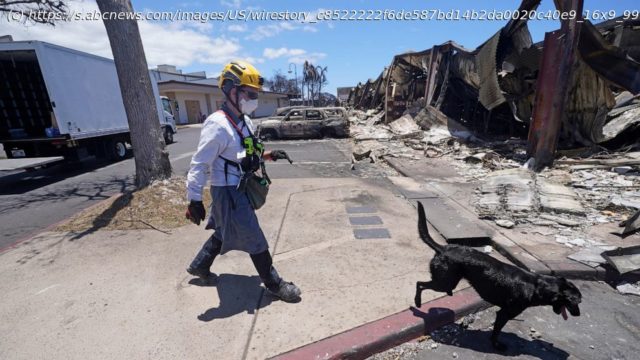As flames tore through a West Maui neighborhood, fleeing residents headed for the only paved road out of town in a dash for safety
As flames tore through a West Maui neighborhood, car after car of fleeing residents headed for the only paved road out of town in a desperate race for safety.
And car after car was turned back toward the rapidly spreading wildfire by a barricade blocking access to Highway 30.
One family swerved around the barricade and was safe in a nearby town 48 minutes later, another drove their 4-wheel-drive car down a dirt road to escape. One man took an dirt road uphill, climbing above the fire and watching as Lahaina burned. He later picked his way through the flames, smoke and rubble to pull survivors to safety.
But dozens of others found themselves caught in a hellscape, their cars jammed together on a narrow road, surrounded by flames on three sides and the rocky ocean waves on the fourth. Some died in their cars, while others tried to run for safety.
“I could see from the bypass that people were stuck on the balconies, so I went down and checked it out,” said Kekoa Lansford, who made several trips into town to look for survivors. What he found was horrible, Lansford said, with dead bodies and flames like a hellish movie scene. “And I could see that people were on fire, that the fire was just being stoked by the wind, and being pushed toward the homes.”
The road closures — some because of the fire, some because of downed power lines — contributed to making historic Lahaina the site of the deadliest U.S. wildfire in more than a century. But there were many problems that day, and in some ways the disaster began long before the fires started.
A flash drought in the region provided plenty of kindling, and Hurricane Dora brought strong winds to Maui as it passed roughly 500 miles (800 kilometers) south of the Hawaii island chain. Those winds downed at least 30 power poles in West Maui, and Hawaiian Electric had no procedure in place for turning off the grid — a common practice in other fire-prone states. Video shot by a Lahaina resident shows a downed powerline setting dry grasses alight, possibly revealing the start of the larger fire.
And later, as the fire began to swallow homes in its ravenous path, Maui County emergency officials declined to use an extensive network of emergency sirens to alert Lahaina’s residents to flee.
During a news conference Tuesday, Maui Police Chief John Pelletier said police officers drove up and down streets, knocking on doors and using loudspeakers to tell people to leave, but he didn’t say exactly where and what time those efforts occurred. The Associated Press has filed public records requests for location reports and other documentation including video and internal communications to clarify the details of the police and fire response, but Maui County has not yet released that information.
A team of Associated Press journalists documented the first hours of the deadly wildfire by interviewing dozens of survivors and public officials, examining public documents and analyzing citizen videos, satellite images and publicly available data. The timeline reveals the chaos that overtook the town.
Shane Treu wakes early on Aug. 8, and is in his backyard when he hears a utility pole snap next to Lahainaluna Road. He sees the downed powerline ignite the grass, and calls 911 at 6:37 a.m. to report the fire.
Small brush fires aren’t unusual for Lahaina, and the fire department declares this one 100% contained by 9:55 a.m. The assurance puts many residents at ease; the high winds have prompted the closure of some public schools for the day, and others have not yet started.






